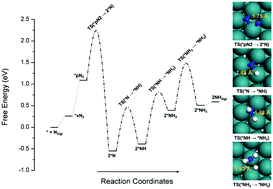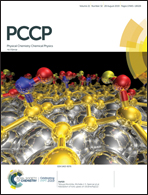Mechanism and kinetics for both thermal and electrochemical reduction of N2 catalysed by Ru(0001) based on quantum mechanics†
Abstract
The conversion of N2(g) to NH3(g) is an important industrial process that plays a vital role in sustaining the current human population. This chemical transformation relies heavily on the Haber–Bosch process (N2 thermal reduction, N2TR), which requires enormous quantities of energy (2% of the world supply) and extreme conditions (200 atm and 500 °C). Alternatively, N2(g) can be reduced to NH3(g) through electrochemical means (N2ER), which may be a less energy intensive and lower-capital approach since the H atoms come from H2O not H2. However, N2ER efficiency is far from satisfactory. In order to provide the basis for developing a new generation of energy efficient processes, we report the detailed atomistic mechanism and kinetics for N2ER on Ru(0001) along with a comparison to N2TR. We obtained these results using a new electrochemical model for quantum mechanics (QM) calculations to obtain free energy surfaces for all plausible reaction pathways for N2ER under a constant electrode potential of 0.0 VSHE. For both processes, the elementary steps involve several steps of breaking of the NN bonds, hydrogenation of surface N2HX or NHX, and NH3 release. We find similar energetics for the NN cleavage steps for both systems. However, the hydrogenation steps are very different, leading to much lower free energy barriers for N2ER compared to N2TR. Thus, N2ER favors an associative route where successive hydrogen atoms are added to N2 prior to breaking the NN bonds rather than the dissociative route preferred by N2TR, where the NN bonds are broken first followed by the addition of Hs. Our QM results provide the detailed free energy surfaces for N2ER and N2TR, suggesting a strategy for improving the efficiency of N2ER.

- This article is part of the themed collection: 2019 PCCP HOT Articles


 Please wait while we load your content...
Please wait while we load your content...
